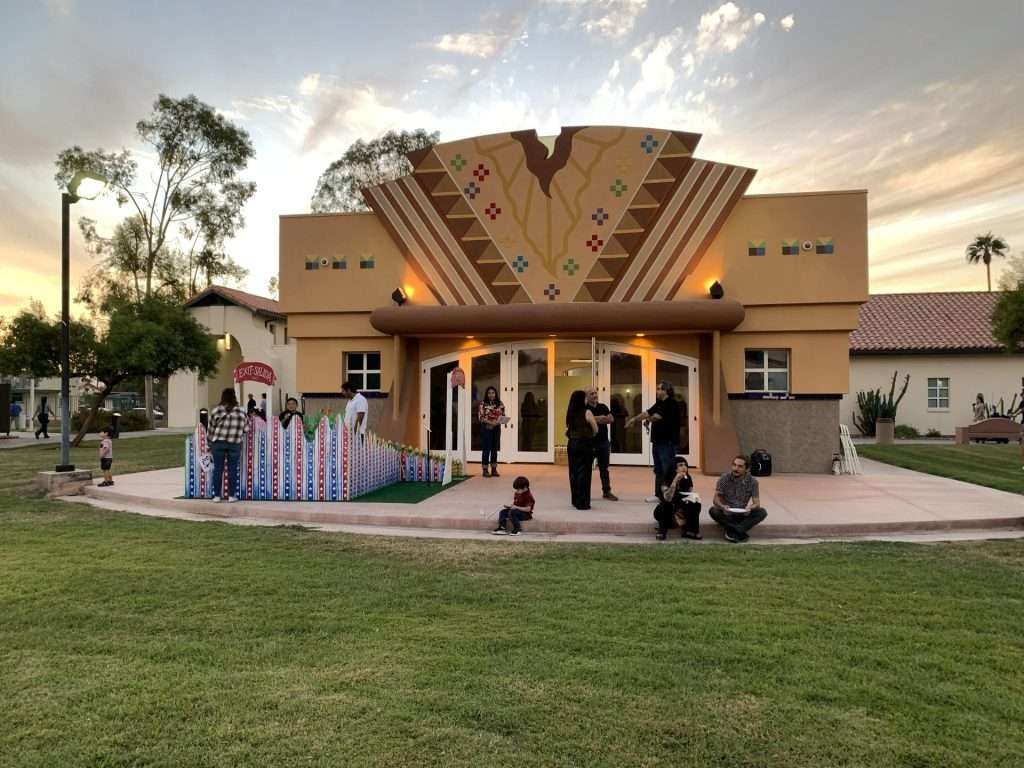CALEXICO — The aesthetic, cultural, and political climate of the Mexico/California border is a particular focus of the MexiCali Biennial, as is an artistic inclination to foreground first-hand experiences of life in the borderlands.
The nonprofit multidisciplinary arts and culture program, which showcases exhibitions in California and Mexico in both established and informal venues, saw its current iteration, “The Land of Milk & Honey,” form a thematic throughline during opening receptions, performances, and cross-border events that took place in Calexico and Mexicali the weekend of Oct. 13-15.


“The Land of Milk & Honey,” which focuses on agricultural themes and takes inspiration from John Steinbeck’s portrayal of the border region as a corrupted Eden of land grabs, ecological destruction, and social injustice, saw exhibitions open at the Steppling Art Gallery on the San Diego State University-Imperial Valley campus in Calexico, Planta Libre Espacio Experimental in Mexicali, and IIC Museo in Mexicali. All three are ongoing through December.
Steppling Art Gallery in Calexico
The small but mighty gallery just off the Rollie Carrillo Quad SDSU-IV currently features 15 artists and artists’ collectives that grapple with regional issues that include the social contingencies faced by migrant workers and the environmental impacts of industrial agriculture.
This exhibition features a variety of media, including photography, paintings, drawings, videos, murals, and sculptural installations. One installation by the Joshua Tree-based artists’ collective, Mojaveland, comprises a corn maze-themed miniature golf course that, in addition to providing family-friendly fun, illustrates corn’s role in processed food manufacture.
Another installation by the Imperial Valley Equity and Justice Coalition features a make-shift gallery air purifier that attempts — with sly humor and a DIY spirit — to combat the toxic dust that blows from the nearby Salton Sea.


Galleries in Mexicali
The Planta Libre gallery in Mexicali features eight artists and artists’ collectives, many of whom adopt an autobiographical or historical approach to examining the borderland’s socio-political concerns. One multimedia installation by Ciudad Juárez-based Alejandra Aragón includes a collection of photographs and ephemera that documents the artist’s personal quest to find her biological father. As a result of her journey, Aragón also found a family damaged by hegemonic masculinity and disrupted by migration.
Tijuana-based artist Shinpei Takeda also examines family histories and memories in an effort to reconstruct the border experiences of diasporic Japanese-Mexican families. His sprawling sculptural installation includes a life-sized raft that functions as a metaphorical repository for the family photos and heirlooms Takeda’s research unearthed.
Art in the Streets
Several Biennial performances took place in outdoor venues the opening weekend of Oct. 13 through 15. Santa Ana-based artist Isidro Pérez García performed a celebratory and indigenous-inspired ritual entitled “Pulquería Chilote” at Casa La Linea in Calexico. With props that included festively decorated oversized table and chairs, Pérez García wielded talismans, shell horns, and home-brewed pulque (a traditional Mexican alcoholic beverage made from maguey leaves) for a convivial band of tipsy participants.
Los Angeles-based artist Annabel Turrado’s Mexicali performance (entitled “Raspado”) involved the artist hand-shaving a large block of ice in the manner of street vendors selling Mexican snow cones, or raspados. Instead of making sugary treats, however, the artist metaphorically shaved away at the federal Immigration and Customs Enforcement detention system (acronym ICE) that has affected many Latinx communities.
Cross-border, Interactive Exhibitions
The San Diego-based artists’ collective Electronic Disturbance Theater provided the weekend’s culminating performance, which took place alongside both sides of the border fence. Performed in a hypnotic call-and-response oration, this solemn trans-border opera described the history and horrors of transnational technological surveillance while thickets of razor wire loomed overhead and a squadron of drones buzzed back and forth.
See also


Donning high-visibility work clothes and with vaguely ambiguous technological instruments in hand, artist Ricardo Dominguez and his EDT collaborators entranced spectators with an hour-long oration both sobering and scholarly. Near the end of the performance, a moment of spontaneous humor arose when a Border Patrol truck drove up and EDT performers began waving their technology instruments in front of the vehicle in a ceremonious gesture of faux benediction, making the Border Patrol briefly an unwitting participant.
The artists and activists of “The Land of Milk & Honey” unflinchingly face the hard social, ecological, and political realities of this complex and compelling border region, but often do so with beauty, metaphor, and humor. Artists can find curiosity, celebration, and even play amid the crises and contingencies the world has to offer — this is their superpower.
Additional “Land of Milk & Honey” programming was exhibited at the Cheech Marin Center for Chicano Art & Culture at the Riverside Art Museum, the Santa Cruz Museum of Art & History, Best Practice Gallery in San Diego, and online at the Library of Congress in Washington, D.C., among other venues. Curators include Ed Gomez, Luis G. Hernandez, Rosalia Romero and April Lillard-Gomez. Additional curation by Enid Baxter Ryce for Santa Cruz MAH exhibition and Emmanuel Ortega at Best Practice Gallery (San Diego).
Guest contributing writer and artist Cynthia Hooper’s videos, essays, paintings, and research-based projects examine and interpret infrastructural landscapes in the United States and Mexico. She has worked with water, agricultural, and industrial issues along the U.S.-Mexico border and in California, Oregon, and Arizona. She has exhibited and screened her work at the Center for Land Use Interpretation in Los Angeles, the Museum of Modern Art in Mexico City, the Centro Cultural Tijuana, Santa Fe Art Institute, and MASS MoCA. Published work includes Places Journal and Arid: A Journal of Desert Art, Design and Ecology. She lives in Northern California.
